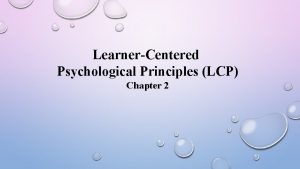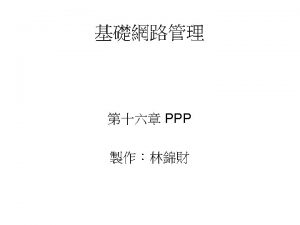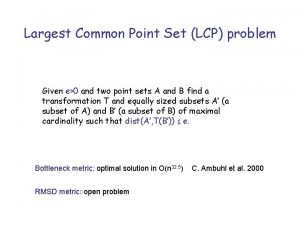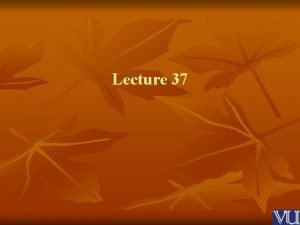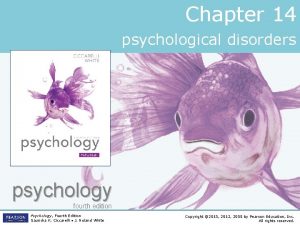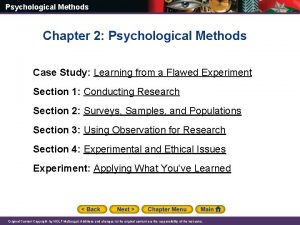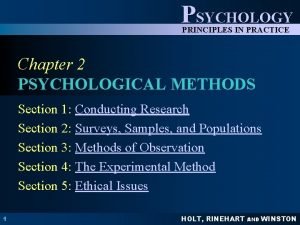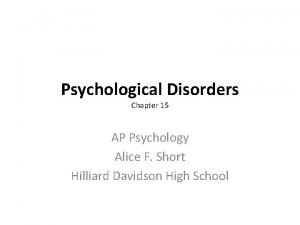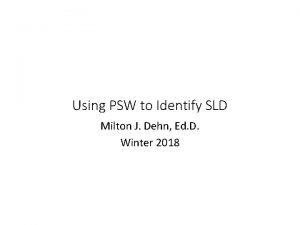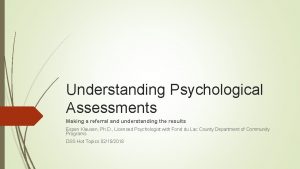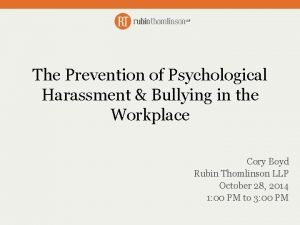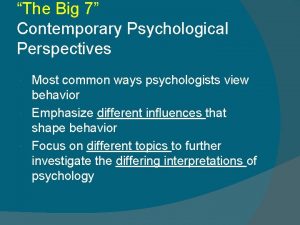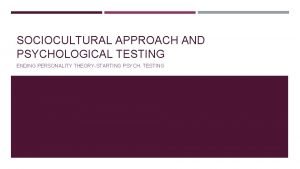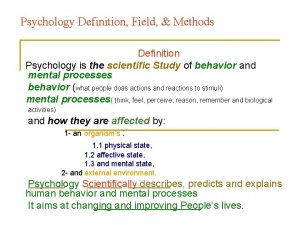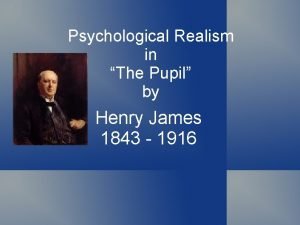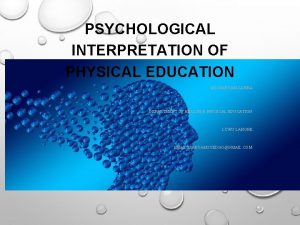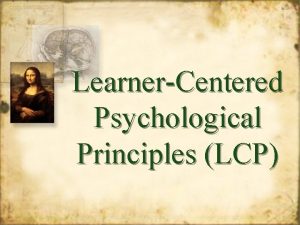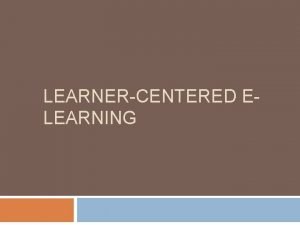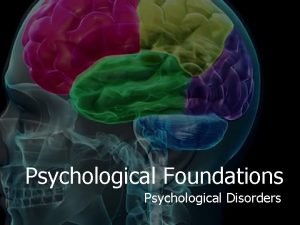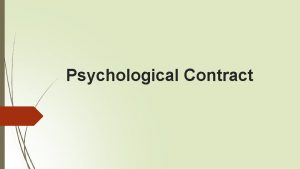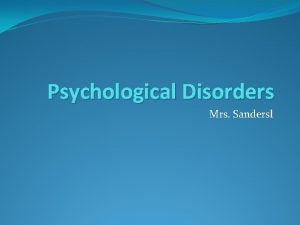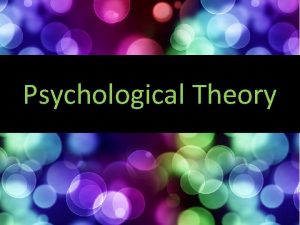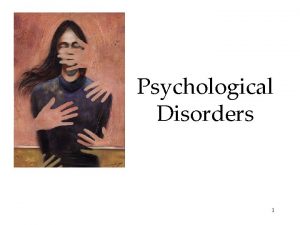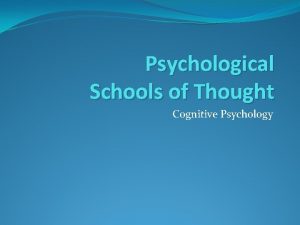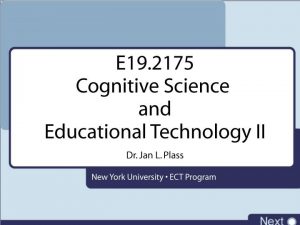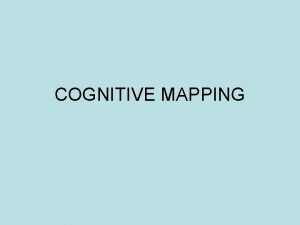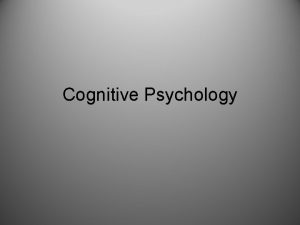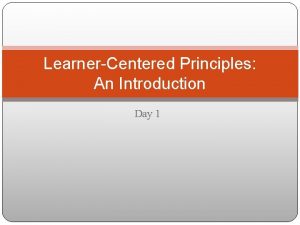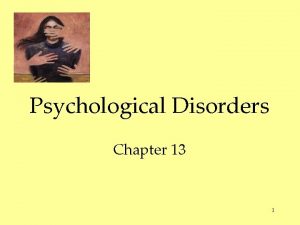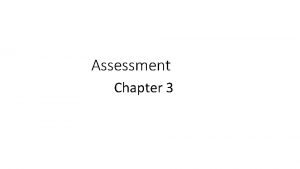LearnerCentered Psychological Principles LCP Chapter 2 6 Cognitive


























- Slides: 26

Learner-Centered Psychological Principles (LCP) Chapter 2

(6) Cognitive and Metacognitive Factors (3) Motivational and Affective Factors (14) Learner. Centered Principles (2) Developmental and Social Factors (3) Individual Differences Factors Advance Organizer for Chapter 2

Learner-Centered Psychological Principles - by the American Psychological Association - the principles pertain to the learner and the learning Ø focus on psychological factors that are primarily INTERNAL Ø principles are intended to deal HOLISTICALLY with learners in the context of real-world learning situations; no principle should be viewed in isolation

Ø the (14) principles influencing learners and learning are divided into those referring to: a. cognitive and metacognitive b. motivational and affective c. developmental and social d. individual differences factors Ø the principles are intended to apply to all learners – from children, to teachers, to administrators, to parents and to community members involved in our educational system

Cognitive and Metacognitive Factors 1. Nature of the learning process. The learning of a complex subject matter is most effective when it is an intentional process of constructing meaning from information and experience. - learning in schools emphasizes the use of intentional processes that students can use to construct meaning from information, experiences and their own thoughts and beliefs - successful learners are active, goal-directed, self-regulating and assume personal responsibility for contributing to their own learning

2. Goals of the learning process The successful learner, over time and with support and instructional guidance, can create meaningful, coherent representations of knowledge. - the strategic nature of learning requires students to be goaldirected; students must generate and pursue personallyrelevant goals - educators can assist learners in creating meaningful learning goals that are consistent with both personal and educational aspirations and interests

3. Construction of Knowledge The successful learner can link new information with existing knowledge in meaningful ways. - knowledge widens and deepens as students continue to build links between new information and experiences and their existing knowledge base - unless new knowledge becomes integrated with the learner’s prior knowledge and understanding, this new knowledge remains isolated and CANNOT be used effectively in new tasks and does not transfer readily to new situations

4. Strategic thinking The successful learner can create and use a repertoire of thinking and reasoning strategies to achieve complex learning goals. - successful learners use strategic thinking in their approach to learning, reasoning, problem solving and concept learning - learners also continue to expand their repertoire of strategies by reflecting on the methods they use to see which work well for them, by receiving guided instruction and feedback, and by observing

- learning outcomes can be enhanced if educators assist learners in developing, applying and assessing their strategic learning skills 5. Thinking about thinking Higher order strategies for selecting and monitoring mental operations facilitate creative and critical thinking. - successful learners can reflect on how they think and learn, set reasonable learning or performance goals and monitor their progress toward their goal

- successful learners also know what to do if a problem occurs or if they are not making sufficient or timely progress toward a goal by generating alternative methods to reach their goal (or reassess the appropriateness and utility of the goal) - instructional methods that focus on helping learners develop these higher order (metacognitive) strategies can enhance student learning and personal responsibility for learning

6. Context of Learning is influenced by environmental factors, including culture, technology and instructional practices. - teachers play a major interactive role with both the learner and the learning environment - cultural or group influences on students can impact many educationally relevant variables, such as motivation, orientation toward learning and ways of thinking - the classroom environment, particularly the degree to which it is nurturing or not, can also have significant impacts on student learning

Motivational and Affective Factors 7. Motivational and emotional influences on learning What and how much is learned is influenced by the learner’s motivation. Motivation to learn, in turn, is influenced by the individual’s emotional states, beliefs, interest and goals, and habits of thinking. - students’ belief about themselves as learners and the nature of learning have a marked influence on motivation; motivational and emotional factors also influence both the quality of thinking and information processing as well as an individual’s motivation to learn

- Positive emotions such as curiosity, generally enhance motivation and facilitate learning and performance - Mild anxiety can also enhance learning and performance by focusing the learner’s attention on a particular task - Intense negative emotions such as anxiety, panic, insecurity and related thoughts generally detract from motivation, interfere with learning and contribute to low performance

8. Intrinsic motivation to learners The learner’s creativity, higher order thinking and natural curiosity all contribute to motivation to learn. Intrinsic motivation is stimulated by tasks of optimal novelty and difficulty, relevant to personal interests and providing for personal choice and control. - intrinsic motivation is facilitated on tasks that learners perceive as interesting and personally relevant and meaningful, appropriate in complexity and difficulty to the learners’ abilities and on which they believe they can succeed

- educators can encourage and support learners’ natural curiosity and motivation to learn by attending to individual differences in learners’ perceptions of optimal novelty and difficulty, relevance and personal choice and control 9. Effects of motivation on effort Acquisition of complex knowledge and skills requires extended learner effort and guided practice. Without learner’s motivation to learn , the willingness to exert this effort is unlikely without coercion

- effort is another major indicator of motivation to learn; the acquisition of complex knowledge and skills demands - educators need to be concerned with facilitating motivation by strategies that enhance learner effort and commitment to learning and to achieving high standards of comprehension and understanding - effective strategies include purposeful learning activities, guided by practices that enhance emotions and intrinsic motivation to learn and methods that increase learners’ perceptions that a is interesting and personally relevant

Developmental and Social Factors 10. Developmental influences on learning As individuals develop, there are different opportunities and constraints for learning. Learning is most effective when differential development within and across physical, intellectual, emotions and social domains is taken into account. - individuals learn best when material is appropriate to their development level and is presented in an enjoyable and interesting way

- because individual development varies across intellectual, social, emotional and physical domains, achievement in different instructional domains may also vary - overemphasis on one type of developmental readiness – such as reading readiness – may preclude learners from demonstrating that they are more capable in other areas of performance - the cognitive, emotional and social development of individual learners and how they interpret life experiences are affected by prior schooling, home, culture and community factors

- early and continuing parental involvement in schooling, and the quality of language interactions and two-way communications between adults and children can influence these developmental areas - awareness and understanding of developmental differences among children with and without emotional, physical or intellectual disabilities, can facilitate the creation of optimal learning contexts

11. Social influences on learning Learning is influenced by social interactions, interpersonal relations and communications with others. - learning settings that allow for social interactions and respect for diversity encourage flexible and social competence - in interactive and collaborative instructional contexts, individuals have an opportunity for perspective taking and reflective thinking that may lead to higher levels of cognitive, social and moral development, as well as self-esteem

- quality personal relationships that provide stability, trust and caring can increase learners’ sense of belonging, selfrespect and self-acceptance and provide a positive climate for learning - positive learning climates can also help to establish the context for healthier levels of thinking, feeling and behaving; such contexts help learners feel safe to share ideas, actively participate in the learning process, and create a learning community

Individual Differences Factors 12. Individual differences in learning Learners have different strategies, approaches and capabilities for learning that are a function of prior experience and heredity. - individuals are born with and develop their own capabilities and talents - through learning and social acculturation, they have acquired their own preferences for how they like to learn and the pace at which they learn; however these preferences are not always

- educators need to help students examine their learning preferences and expand or modify them, if necessary - educators need to be sensitive to individual differences, in general; they also need to attend to learner perceptions of the degree to which these differences are accepted to by varying instructional methods and materials

13. Learning and diversity Learning is most effective when differences in learners’ linguistic, cultural and social backgrounds are taken into account. - careful attention to the above-mentioned factors in the instructional setting enhances the possibilities for designing and implementing appropriate learning environment - when learners perceive that their individual differences in abilities backgrounds, cultures and experiences are valued, respected and accommodated in learning tasks and contexts, levels of motivation and achievement are enhanced

14. Standards and assessment Setting appropriately high and challenging standards and assessing the learner as well as learning progress – including diagnostic process and outcome assessment – are integral parts of the learning process. - effective learning takes place when learners feel challenged to work towards appropriately high goals, therefore, appraisal of the learner’s cognitive strengths and weaknesses, as well as current knowledge and skills, is important for the selection of instructional materials of an optimal degree of difficulty

Summary of the (14) Principles Categorized In five Areas Knowledge base Strategic processing and control Motivation and affect Development and Individual Differences Situation or context learners’ previous knowledge will influence new learning develop new skills to reflect and regulate thoughts and behavior intrinsic motivation learner has his own unique combination of genetic and environment factors learning happens in the context of society as well as within an individual
 Learner centered psychological principles
Learner centered psychological principles Ppp0 lcp down
Ppp0 lcp down Lcp disciplina
Lcp disciplina Control network
Control network Problem mit lcp
Problem mit lcp Cognitive and non cognitive religious language
Cognitive and non cognitive religious language Five principles of psychological functioning
Five principles of psychological functioning Chapter 18 psychological disorders review worksheet
Chapter 18 psychological disorders review worksheet Chapter 18 psychological disorders
Chapter 18 psychological disorders Chapter 14 psychological disorders
Chapter 14 psychological disorders Chapter 2 psychological methods
Chapter 2 psychological methods Psychology chapter 2 section 1
Psychology chapter 2 section 1 Chapter 14 psychological disorders
Chapter 14 psychological disorders Ap psychology chapter 15 psychological disorders
Ap psychology chapter 15 psychological disorders Chapter 9 early childhood cognitive development
Chapter 9 early childhood cognitive development Chapter 5 cognitive development in infancy and toddlerhood
Chapter 5 cognitive development in infancy and toddlerhood Milton dehn
Milton dehn Referral question example
Referral question example Very superior intelligence
Very superior intelligence Marsh et al
Marsh et al What is interactive communication model
What is interactive communication model Psychological perspectives
Psychological perspectives Psychological testing examples
Psychological testing examples Psychology definition
Psychology definition Define psychological thriller
Define psychological thriller The pupil henry james
The pupil henry james Psychological interpretation of physical education
Psychological interpretation of physical education
